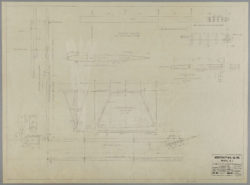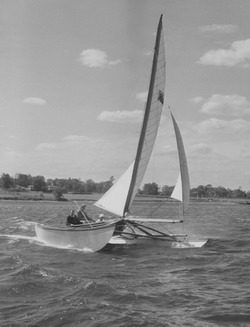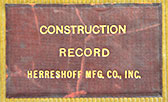HMCo #1519s Sea Spider
Particulars
Type: Catamaran
Designed by: ASdeWH
Setup: 1944
Delivered: 1946-4-9 ?
Construction: Wood
LOA: 25' (7.62m)
Rig: Marconi Sloop
Centerboard: yes
Ballast: None
Built for: Crane, Cornelius
Amount: $3,000.00
Note(s) in HMCo Construction Record: Built in 1944. Thru Sparkman & Stephens
Note: Particulars are primarily but not exclusively from the HMCo Construction Record. Supplementary information not from the Construction Record appears elsewhere in this record with a complete citation.
Images
-
Anon. Photographer (Providence Sunday Journal, Copyright). "Sea Spider [#1519s.]" Photograph, probably between 1944-1945.
Further Image Information
Created by: Anon. Photographer (Providence Sunday Journal, Copyright).
Image Caption: Sea Spider.
Image Date: 1944----1945 ?
Collection: Herreshoff Marine Museum Collection.
Image is copyrighted: Yes, used with permission
Copyright holder: Herreshoff Marine Museum, Bristol, Rhode Island, www.herreshoff.org.
Drawings

List of drawings:
Drawings believed to have been first drawn for, or being first referenced to
HMCo #1519s Sea Spider are listed in bold.
Click on Dwg number for preview, on HH number to see at M.I.T. Museum.
- Dwg 042-014 (HH.5.03336); Sails > 25 ft. Catamaran, Sail Plan (1944-02-23 ?)
- Dwg 042-016 (HH.5.03338); 25' Catamaran Spars [Jib Boom, Main Boom, Bow Sprit] (1944-02-29)
- Dwg 042-015 (HH.5.03337); 25 ft. Catamaran, Hull & Car (1944-03-04)
- Dwg 042-017 (HH.5.03339); Construction Dwg > 25' Catamaran Details [Centerboards, Clevis Fitting for Bowsprit, Shrouds, Tiller, Forward Hull Tie] (1944-03-04)
- Dwg 042-000 (HH.5.03345); Turnbuckles for Mast Trusses, Catamaran # 1519 (1944-11-20)
Note: The Haffenreffer-Herreshoff Collection is copyrighted by the Francis Russell Hart Nautical Collections of the MIT Museum in Cambridge, Mass. Permission to incorporate information from it in the Herreshoff Catalogue Raisonné is gratefully acknowledged. The use of this information is permitted solely for research purposes. No part of it is to be published in any form whatsoever.
Documents
Other Contemporary Text Source(s)
"1945. ... Lemos finished and launched a 28 1/2-foot overall auxiliary sloop, the Trade Winds, for C. C. Cornell Jr. Cornell was a student at La Salle Academy, so the academy band turned out to give tone to the launching. Herreshoff built the catamaran, Sea Spider. As far as I know, these were the only two pleasure craft built during the year. ..." (Source: Davis, Jeff. Yachting in Narragansett Bay. Providence, 1946, p. 126.)
"... Outstanding champion of the modern twin-hull class is the 25-foot plywood Herreshoff Sea Spider. Streaking past the Rhode Island shore at close to 1000 feet a minute, she has outrun every sailing craft she's met, ..." (Source: Anon. [That's Speed.] Science Illustrated, Volume 1, 1946, p. 68?)
"The Herreshoff Co. has sold the catamaran Sea Spider (see January [1946] Yachting, page 86, if you're interested) to Cornelius Crane, of Ipswich, Mass. Sparkman and Stephens were the brokers." (Source: Davis, Jeff. "Narragansett Bay Gossip. Short Ends." Yachting Magazine, June 1946, p. 148.)
Archival Documents
"[Item Transcription:] [Typewritten note:] 'Observations on Trials of the Catamaran 'SEASPIDER' [#1519s]
These trials have proven that there are no bad effects resulting from the system of holding the hulls rigidly in line with each other instead of allowing them to pitch individually as on the earlier catamarans. The design of the connecting structure has so far proven capable of holding the hulls rigidly in line without any apparent strain on any of its parts, and this structure is no heavier than that used on the earlier boats. I am quite convinced that the performance of this craft in a seaway is better than that of the 'AMMERILLIS' [sic, i.e. #1232s AMARYLLIS].
The form of the hulls, imbodying [sic] the triangular sections, which lends itself so well to plywood construction, seems to be entirely satisfactory as far as performance is concerned.
When on the wind, there seems to be more leeway than I had expected, indicating that centerboards might be necessary for best results. I am afraid the sharp pointed keels will be rather vulnerable to grounding on a rough bottom and they should be reinforced by heavy metal sheathing where they are likely to take the ground. A centerboard boat would have a heavier more rounded keel which would be able to take more abuse.
On the first trip the side trusses proved inadequate to prevent buckeling [sic] of the mast; this was corrected by increasing the length of the spreaders from 12in to 18in and fitting turnbuckles to get proper tension in the wires. It was also found necessary to fit halyard winches in order to make the sails set properly. Everything else about the rig has proven very satisfactory. The swiveling mast seems to accomplish its purpose of streamlining the leading edge of the mainsail but perhaps it is a refinement that is unnecessary. It is a little annoying to have it slat back and forth while laying at a mooring and while hoisting sail.
Apparently the sail area is about right for the prevailing summer southwest winds in the bay. Unfortunately, this time of the year it is either blowing a gale or is calm, so we have not had a good trial under whole said [sic] conditions. The position of the center of effort seems correct; however, she is not sensitive to quite a change in this position. We found that it was possible to sail her with the unreefed mainsail alone. It was hard to get her started but as soon as she had steerage way she was under perfect control, and only carried a moderate weather helm. Like the 'AMMERILLIS' [sic] she is very slow in stays, under some conditions, loosing all headway when coming about; but on account of the jib sheet arrangement she is still under control.
Possibly larger rudders might help to bring her about a little quicker.
It is necessary for the crew to be able to go nearly the whole length of the boats. The excessive slope of the decks makes this rather difficult. This could be made safer by having a life line from end to end, and attached to the shroud about three feet above deck, fitting toe rails about one third way in from the outer edge, and using anti-skid paint on the decks. I am not sure whether the advantages gained by sloping the hulls are important enough to outweigh the advantage of a level deck.
I have thought out another design embodying a semi-rigid attachment of the hulls. Probably there would be little improvement in this design as far as performance is concerned; but it has certain simplifications that should reduce the cost some, and the design will make it easier for the crew to move about over the whole structure. The features of this design can best be understood from a drawing.
On a trial November 29th [1944], with one on board and all sail set, it was found that, with the sails trimmed flat, the mast still buckled dangerously between the spreaders and the stay attachment. Probably the best way to correct this will be to glue strips of wood each side of the mast along this region. Under this light condition, the boat seemed to be quite tender, and the excessive leeway was particularly noticeable. It may be advisable to carry some ballast in the hulls. This will increase her stability and by setting the hulls deeper in the water, will partly overcome the tendency to slide off. I remember my Father saying that his catamarans were improved by putting ballast in the after part of the hulls.' [Note: N. G. Herreshoff did not ballast his catamarans. He did indeed put a man on the stern of the windward hull, but only to prevent this hull from dipping its bow into the water. This was not done to increase stability nor to improve pointing ability, as A. S. deW Herreshoff incorrectly assumes.]" (Source: Herreshoff, A. Sidney deW. (creator). Notes. MIT Museum, Hart Nautical Collections, Haffenreffer-Herreshoff Collection Item HH.6.048. Box HAFH.6.2B, Folder Catamaran. 1944-11-30.)
1 2
"[Item Description:] Newspaper clipping titled 'SEA SPIDER. The Latest of the Herreshoff Catamarans Sails Much Like an Iceboat. Carries Up to 450 Feet of Canvas and Is Much Faster than a Cup Yacht' with full-page story by Jeff Davis about #1519s SEA SPIDER incl. 5 photos." (Source: Providence Sunday Journal (creator). Newspaper Clipping. Halsey C. Herreshoff Collection at the Herreshoff Marine Museum Item MRDE14_01160. Folder [no #]. 1945-08-26.)
1
Note: This list of archival documents contains in an unedited form any and all which mention #1519s Sea Spider even if just in a cursory way. Permission to digitize, transcribe and display is gratefully acknowledged.
Supplement
From the 1920 and earlier HMCo Index Cards at the MIT Museum
- Note: The vessel index cards comprise two sets of a total of some 3200 cards about vessels built by HMCo, with dimensions and information regarding drawings, later or former vessel names, and owners. They were compiled from HMCo's early days until 1920 and added to in later decades, apparently by Hart Nautical curator William A. Baker and his successors. While HMCo seems to have used only one set of index cards, all sorted by name and, where no name was available, by number, later users at MIT apparently divided them into two sets of cards, one sorted by vessel name, the other by vessel number and greatly expanded the number of cards. Original HMCo cards are usually lined and almost always punched with a hole at bottom center while later cards usually have no hole, are unlined, and often carry substantially less information. All cards are held by the Francis Russell Hart Nautical Collections of the MIT Museum in Cambridge, Mass. and permission to display is gratefully acknowledged.
From the 2000 (ca.) Transcription of the HMCo Construction Record by Vermilya/Bray
Month: April
Day: 09
Year: 1946
E/P/S: S
No.: 1519
Name: Sea Spider
Amount: 3000
Notes Constr. Record: thru Sparkman & Stephens. Built in 1944
Last Name: Crane
First Name: Cornelius
Source: Vermilya, Peter and Maynard Bray. "Transcription of the HMCo. Construction Record." Unpublished database, ca. 2000.
Note: The transcription of the HMCo Construction Record by Peter Vermilya and Maynard Bray was performed independently (and earlier) than that by Claas van der Linde. A comparison of the two transcriptions can be particularly useful in those many cases where the handwriting in the Construction Record is difficult to decipher.
Link to the Herreshoff Registry
The Herreshoff Registry, founded by Steve Nagy and later administered by Teeter Bibber, can be particularly useful for researching the provenance of Herreshoff-built sailing vessels. Permission to link to the Registry is gratefully acknowledged! Note: The Herreshoff Registry was offline in Spring of 2022. As a temporary measure here is a link to a backup file from January 2021. It is unclear how much the Registry has been updated since then.
Research Note(s)
"[See also:] Observations on trials of the catamaran Sea Spider (11/30/1944). In: Technical and Business Records pertaining to the Herreshoff Manufacturing Company, Series VI, Folder HH.6.48 (Catamaran), Box HAFH.6.2B." (Source: Hasselbalch, Kurt and Frances Overcash and Angela Reddin: Guide to The Haffenreffer-Herreshoff Collection. Francis Russell Hart Nautical Collections, MIT Museum, Cambridge, Mass., 1997, p. 63-79.)
"Davis, Jeff. Yachting in Narragansett Bay. Providence, 1946, p. 126 says that Sea Spider was built in 1945, one of only two pleasure vessels built that year in Narragansett Bay. Sea Spider was actually built in 1944 and test-sailed in November 1944. The date in the Construction Record, April 9, 1946 thus appears to be the date that Sea Spider was sold to Cornelius Crane." (Source: van der Linde, Claas. February 14, 2011.)
Note: Research notes contain information about a vessel that is often random and unedited but has been deemed useful for future research.
Herreshoff Catalogue Raisonné.
All rights reserved. No reproduction, adaptation, or distribution of any part of this document or any information contained herein by any means whatsoever is permitted without prior written permission. For the full terms of copyright for this document please click here. Last revision 2025-05-15.
© 2025,

